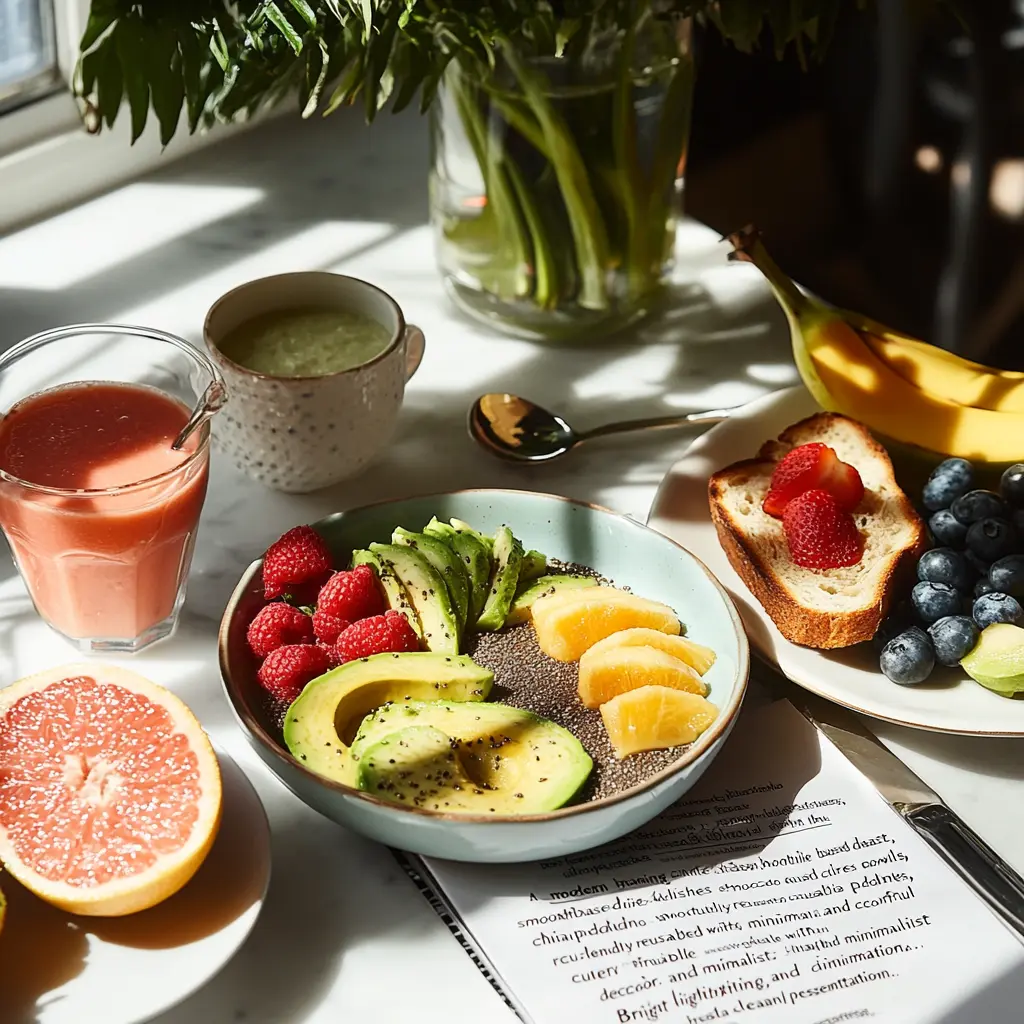Introduction
Breakfast is often hailed as the most important meal of the day. But have you ever wondered why? Across cultures, this morning ritual takes on countless forms, reflecting histories, preferences, and values. From hearty platters in the United States to the delicate artistry of Japanese meals, breakfast dishes tell a story as varied as humanity itself. This article dives into these traditions, exploring what defines a typical breakfast dish, the global flavors that captivate taste buds, and the evolution of modern breakfast trends.
Part 1: Understanding Breakfast Traditions
The Importance of Breakfast Across Cultures
Breakfast is more than just a meal; it’s a symbol of the day ahead. In many cultures, it serves as a foundation for physical and mental energy. Studies frequently highlight the role of a balanced breakfast in boosting productivity, stabilizing blood sugar levels, and enhancing mood. In fact, skipping this crucial meal can leave you feeling sluggish or unfocused.

In India, breakfast emphasizes warm and spiced comfort, while in European countries like Italy, breakfast is often quick and sweet. Interestingly, the diversity of breakfast reflects both cultural priorities and available ingredients. For instance, rice dominates breakfast tables in much of Asia, while bread is a staple across Europe and North America. Whether simple or elaborate, the first meal of the day holds profound meaning globally.
Historical Evolution of Breakfast Foods
Breakfast has undergone remarkable transformations over the centuries. Ancient Egyptians began their mornings with simple fare, such as bread and beer (yes, really), while medieval Europeans often ate leftovers from the previous night’s meal. The concept of distinct breakfast foods didn’t arise until the Industrial Revolution, when factory schedules necessitated quick, energy-packed options.
In the 19th century, breakfast staples like oatmeal and porridge gained popularity, providing affordable nutrition. By the mid-20th century, convenience foods—such as cereal and toast—became household staples, particularly in Western countries. Today, breakfast reflects both tradition and innovation, with some dishes steeped in heritage and others tailored for the fast-paced modern lifestyle.
Part 2: Typical Breakfast Dishes Around the World
Breakfast is a universal ritual, yet the foods that grace morning tables vary widely. From hearty meals to light bites, these dishes reflect the essence of local ingredients, climate, and culture. Let’s take a flavorful journey around the globe and explore what a typical breakfast dish looks like in various regions.
North America
United States – The Classic American Breakfast
The United States is famous for its robust breakfast offerings, with the classic American breakfast reigning supreme. This typically includes scrambled eggs, pancakes, sausages, and hash browns, all served with coffee or orange juice.
Pancakes, often drenched in maple syrup or topped with fruit, highlight America’s penchant for sweet and savory combinations. These breakfasts are not just about sustenance but also about indulgence, especially on weekends when families come together to enjoy leisurely morning meals.
Canada – Pancakes with Maple Syrup
In Canada, breakfast features a similar sweetness but with a national twist. Pancakes are a staple, paired with the country’s world-renowned maple syrup. The addition of peameal bacon or baked beans adds a hearty edge, reflecting Canada’s love for comforting yet straightforward cuisine.
Europe
United Kingdom – Full English Breakfast
A quintessential English breakfast is a hearty affair, often referred to as a “Full English.” This plate is packed with eggs, grilled tomatoes, baked beans, sausages, mushrooms, and toast. Tea or coffee accompanies the meal, making it both satisfying and energizing.
What makes this dish iconic is its ability to combine different textures and flavors, from the crispy toast to the tangy sweetness of tomatoes. It’s a celebration of classic English ingredients, prepared in a straightforward yet fulfilling manner.
France – Croissants and Café au Lait
In France, mornings are marked by simplicity and elegance. A typical breakfast consists of a flaky, buttery croissant paired with café au lait or espresso. Occasionally, a baguette with jam or honey is added to the mix.
French breakfasts are light compared to their English counterparts, focusing on quality over quantity. The emphasis lies on starting the day with a delicate, enjoyable experience rather than a heavy meal.
Germany – Bread, Cold Cuts, and Cheese
Germany embraces variety with its traditional breakfast, known as Frühstück. It often includes an assortment of fresh bread rolls, cold cuts like salami, cheeses, and sometimes hard-boiled eggs.
Germans value freshness and balance in their breakfast spread, pairing savory items with marmalade or honey. This harmonious combination caters to both energy needs and taste preferences, making it a balanced start to the day.
Asia
China – Congee and Dim Sum
In China, breakfast can vary greatly by region, but congee—a rice porridge—is a staple. It’s often served with pickled vegetables, peanuts, or boiled eggs. Dim sum, featuring dumplings and buns, is another popular option in urban areas.
Chinese breakfasts prioritize warmth and simplicity, aiming to provide comfort and nutrition. Congee, in particular, reflects this focus with its mild flavor and versatility.
Japan – Rice, Miso Soup, and Grilled Fish
A traditional Japanese breakfast is a balanced and wholesome meal. It typically includes steamed rice, miso soup, grilled fish, and pickled vegetables. Sometimes, a raw egg or fermented soybeans (natto) are added for additional protein.
This minimalist breakfast emphasizes harmony between flavors and textures, reflecting Japan’s culinary philosophy of mindful eating.
India – Idli, Dosa, and Chai
Indian breakfasts are vibrant and diverse, often varying by region. In the south, dishes like idli (steamed rice cakes) and dosa (thin rice crepes) are served with coconut chutney and sambar, a lentil-based stew. In the north, parathas stuffed with potatoes or paneer are popular.
Chai, a spiced tea, is an essential accompaniment, tying the meal together with its rich aroma and flavor. Indian breakfasts are not only nourishing but also deeply tied to the country’s culinary heritage.
Africa
Nigeria – Akara and Pap
In Nigeria, akara (bean fritters) paired with pap (a corn-based porridge) is a classic breakfast. The fritters are deep-fried, offering a crunchy texture that complements the creamy porridge.
This combination is quick, filling, and packed with local flavors, reflecting Nigeria’s vibrant food culture.
Ethiopia – Genfo and Coffee
Ethiopian breakfasts often feature genfo, a thick porridge made from barley or wheat flour, served with clarified butter and spiced berbere. Coffee, integral to Ethiopian culture, frequently accompanies the meal.
This hearty breakfast provides lasting energy, with the spices and butter offering a comforting start to the day.
South America
Brazil – Pão de Queijo and Coffee
Brazilian mornings often begin with pão de queijo, delightful cheese bread rolls that are crispy on the outside and chewy on the inside. Coffee, a beloved beverage in Brazil, is an essential companion.
These rolls highlight Brazil’s love for simple yet flavorful foods, making breakfast a cherished part of the day.
Colombia – Arepas and Hot Chocolate
In Colombia, breakfast revolves around arepas—grilled cornmeal cakes often filled with cheese or butter. Hot chocolate, occasionally mixed with cheese (yes, cheese), is a popular drink alongside this dish.
This pairing showcases Colombia’s culinary creativity and its focus on comfort food that feels like a warm hug on a plate.
Breakfast dishes around the world share a common goal of providing nourishment, but their diversity is a testament to cultural uniqueness. Whether it’s the savory richness of a Full English or the delicate sweetness of French pastries, these meals tell stories that go far beyond the morning table.
Part 3: Nutritional Aspects of Breakfast Dishes
Breakfast sets the tone for the day, and its nutritional value cannot be overstated. While morning meals vary widely across cultures, the common thread is the importance of balancing macronutrients to fuel the body and mind. Let’s explore how breakfast contributes to daily nutrition and energy levels.
Balancing Macronutrients in Breakfast
A balanced breakfast includes a mix of carbohydrates, proteins, and fats to support sustained energy throughout the day. Carbohydrates, found in foods like bread, rice, or pancakes, provide quick energy. However, pairing them with protein-rich options—such as eggs, fish, or beans—slows digestion, ensuring a steady release of energy. Healthy fats from sources like avocado, nuts, or cheese contribute to satiety and brain function.
For instance, a Japanese breakfast of rice, miso soup, and grilled fish exemplifies this balance. Similarly, an Ethiopian genfo with butter and spices or an Indian dosa with lentil-based sambar incorporates diverse nutrients into one meal. These combinations are not just traditional; they are time-tested ways to meet the body’s needs.
The Role of Breakfast in Daily Energy Levels
Skipping breakfast often leads to low energy, irritability, and poor concentration. Conversely, a well-rounded morning meal can stabilize blood sugar levels, sharpen focus, and improve mood. This is particularly important for students and professionals who need sustained mental clarity.
Take the Full English breakfast as an example. While it may seem indulgent, the mix of proteins (eggs, sausages), fiber (beans, tomatoes), and complex carbs (toast) ensures a slow, steady energy release. Similarly, the light yet nutrient-dense nature of a French breakfast—croissant paired with coffee—provides a quick boost, particularly for lighter morning appetites.
Modern Adaptations for Health-Conscious Eaters
Many people today are seeking healthier breakfast options. Whole-grain cereals, plant-based milk, and nutrient-packed smoothies are becoming staples worldwide. Even traditional dishes like congee are being adapted, with quinoa or millet replacing white rice for an added nutritional punch.
Breakfast isn’t just about starting the day—it’s about starting strong. By prioritizing balance and nourishment, this meal can become a cornerstone of both physical health and productivity. Whether traditional or modern, a thoughtfully prepared breakfast is an investment in well-being.
Part 4: Modern Trends in Breakfast Choices
In today’s fast-paced world, breakfast is evolving to meet the demands of health-conscious eaters, busy lifestyles, and cultural shifts. While traditional breakfast dishes still hold their charm, modern trends highlight innovation and convenience. Here’s how breakfast is adapting to contemporary tastes and habits.

The Rise of Plant-Based Breakfasts
Plant-based diets are gaining traction globally, influencing how people approach their morning meals. From avocado toast to tofu scrambles, plant-forward options are becoming mainstream. These breakfasts focus on whole, minimally processed ingredients that align with sustainable and health-conscious living.
Smoothie bowls, loaded with fresh fruits, nuts, seeds, and plant-based milk, are a perfect example of this trend. They’re not only Instagram-worthy but also packed with vitamins, fiber, and antioxidants. Similarly, chia pudding—made from chia seeds and almond or coconut milk—is a nutrient-dense option gaining popularity for its ease of preparation and versatility.
Even traditional dishes are being reimagined. For instance, congee can be made with quinoa and topped with roasted vegetables, while dosa batter is adapted to include millet or oats. These twists honor tradition while meeting modern dietary preferences.
Convenience Foods – Instant and On-the-Go Options
As mornings get busier, convenience is becoming a priority. Pre-packaged breakfast items like granola bars, overnight oats, and instant smoothie mixes are replacing sit-down meals for many. These options are designed to provide quick nourishment without compromising on nutrition.
The popularity of breakfast sandwiches and wraps also reflects this need for speed. Made with whole-grain bread, eggs, or plant-based proteins, they’re a portable and satisfying choice for commuters. Technology plays a role here, too, with apps and meal kits offering easy solutions for balanced breakfasts on the go.
The Influence of Social Media on Breakfast Trends
Social media has revolutionized how we think about breakfast. Platforms like Instagram and TikTok are filled with vibrant recipes and aesthetically pleasing breakfast spreads. Dishes like “cloud eggs,” rainbow smoothie bowls, or pancake art are not just delicious but visually stunning.
This trend has encouraged people to experiment with flavors, colors, and presentation, turning breakfast into a creative outlet. Moreover, influencers and food bloggers emphasize the importance of nutrition, helping audiences make better choices while still enjoying their meals.
Breakfast today is about flexibility and personalization. Whether you’re embracing plant-based eating, grabbing a quick wrap, or crafting a photo-worthy smoothie bowl, there’s a modern twist to suit every palate and schedule.
Frequently Asked Questions (FAQs)
What are some healthy breakfast options?
Healthy breakfasts focus on balance and variety. Options like oatmeal topped with fresh fruits and nuts, Greek yogurt with granola, or a veggie-packed omelet are excellent choices. Smoothies made with leafy greens, bananas, and plant-based milk are quick yet nutrient-rich. For those who prefer something savory, avocado on whole-grain toast or quinoa bowls with roasted vegetables offer both flavor and nourishment.
Is it necessary to eat breakfast every day?
While breakfast is often considered the most important meal, its necessity varies from person to person. For many, eating a balanced breakfast boosts energy and focus. However, some prefer intermittent fasting or find their energy levels unaffected by skipping breakfast. The key is listening to your body and maintaining an overall nutritious diet throughout the day.
How do breakfast habits vary between cultures?
Breakfast habits differ greatly around the world. In Western cultures, breakfast often includes bread, eggs, or cereals, while in Asia, rice-based dishes like congee or steamed buns dominate. African and Middle Eastern breakfasts feature flatbreads, legumes, and spiced teas. These differences highlight the influence of geography, climate, and cultural heritage on morning meals.
What are some quick breakfast ideas for busy mornings?
For busy mornings, options like overnight oats, granola bars, or fruit and nut parfaits are lifesavers. Breakfast wraps with scrambled eggs and veggies, or pre-made smoothie packs that blend in seconds, are convenient as well. Another idea is to batch-cook items like muffins or breakfast burritos, making them easy to grab and heat up during the week.
How can I make my breakfast more nutritious?
To boost breakfast nutrition, incorporate whole grains, lean proteins, and healthy fats. For example, replace refined cereals with oatmeal or whole-grain toast. Add seeds like flax or chia to your meals for extra fiber and omega-3s. Including fresh fruits or vegetables ensures essential vitamins and minerals are part of your diet.
What are common breakfast beverages worldwide?
Coffee and tea are the most common breakfast beverages, enjoyed in various forms across cultures. For instance, masala chai is popular in India, while Ethiopian breakfasts often feature traditional coffee ceremonies. Juices, particularly orange or tropical blends, are also widespread. In some regions, hearty soups or broths double as both meals and beverages to start the day.
Breakfast continues to inspire creativity, conversation, and connection, offering a delightful start to every morning. Whether traditional or modern, sweet or savory, this meal celebrates the unique ways we nourish ourselves and honor our cultures.
Conclusion
Breakfast, as the first meal of the day, is far more than just a source of energy. It is a reflection of cultural identity, a showcase of culinary creativity, and a pivotal part of health and wellness. Whether you’re savoring a traditional dish like Japan’s grilled fish and miso soup, indulging in the comforting flavors of a Full English breakfast, or whipping up a quick smoothie on a busy morning, breakfast represents a universal moment of care and nourishment.
Through this exploration, it’s clear that a typical breakfast dish is as diverse as the people who prepare it. Yet, amidst this variety lies a common goal: to provide a delicious and energizing start to the day. By embracing both traditional recipes and modern trends, breakfast continues to evolve, meeting the needs of individuals and families around the globe.
So, whether your morning routine involves a steaming bowl of congee, a flaky croissant, or a vibrant smoothie bowl, remember that breakfast isn’t just about feeding the body—it’s about feeding the soul, one bite at a time.

